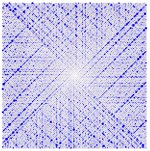NobleSavage
Veteran Member
And a second question, I understand they are used in cryptography, but how?
Thanks, I'm familiar with the process of public key cryptography, but I never knew the why. I guess the discrete logarithm problem was the idea behind the movie Sneakers. Some mathematician figured out a way to make encryption worthless (they were fuzzy on the details) and the rest was your typical government espionage drama with Robert Redford as a good guy.
Aside from the cryptographic approach, primes are cool because they're not part of anything else. They're atoms. All the other numbers break down, like molecules being broken down into their constituent atoms. But primes don't break down. They're the building blocks.
In addition to that, if you lay out all of the integers in any pattern you want, then cross out all of the non-primes, the remaining primes almost, but not quite, make a pattern of their own. Since humans are nearly OCD when it comes to patterns, they fascinate us, trying to see the almost-pattern that isn't there, and trying to understand the formula-that-isn't that underlies them.
Aside from the cryptographic approach, primes are cool because they're not part of anything else. They're atoms. All the other numbers break down, like molecules being broken down into their constituent atoms. But primes don't break down. They're the building blocks.
In addition to that, if you lay out all of the integers in any pattern you want, then cross out all of the non-primes, the remaining primes almost, but not quite, make a pattern of their own. Since humans are nearly OCD when it comes to patterns, they fascinate us, trying to see the almost-pattern that isn't there, and trying to understand the formula-that-isn't that underlies them.
You have a link to any of these "almost-patterns" represented visually?

Aside from the cryptographic approach, primes are cool because they're not part of anything else. They're atoms. All the other numbers break down, like molecules being broken down into their constituent atoms. But primes don't break down. They're the building blocks.
In addition to that, if you lay out all of the integers in any pattern you want, then cross out all of the non-primes, the remaining primes almost, but not quite, make a pattern of their own. Since humans are nearly OCD when it comes to patterns, they fascinate us, trying to see the almost-pattern that isn't there, and trying to understand the formula-that-isn't that underlies them.
You have a link to any of these "almost-patterns" represented visually?

Aside from the cryptographic approach, primes are cool because they're not part of anything else. They're atoms. All the other numbers break down, like molecules being broken down into their constituent atoms. But primes don't break down. They're the building blocks.
In addition to that, if you lay out all of the integers in any pattern you want, then cross out all of the non-primes, the remaining primes almost, but not quite, make a pattern of their own. Since humans are nearly OCD when it comes to patterns, they fascinate us, trying to see the almost-pattern that isn't there, and trying to understand the formula-that-isn't that underlies them.
You have a link to any of these "almost-patterns" represented visually?
